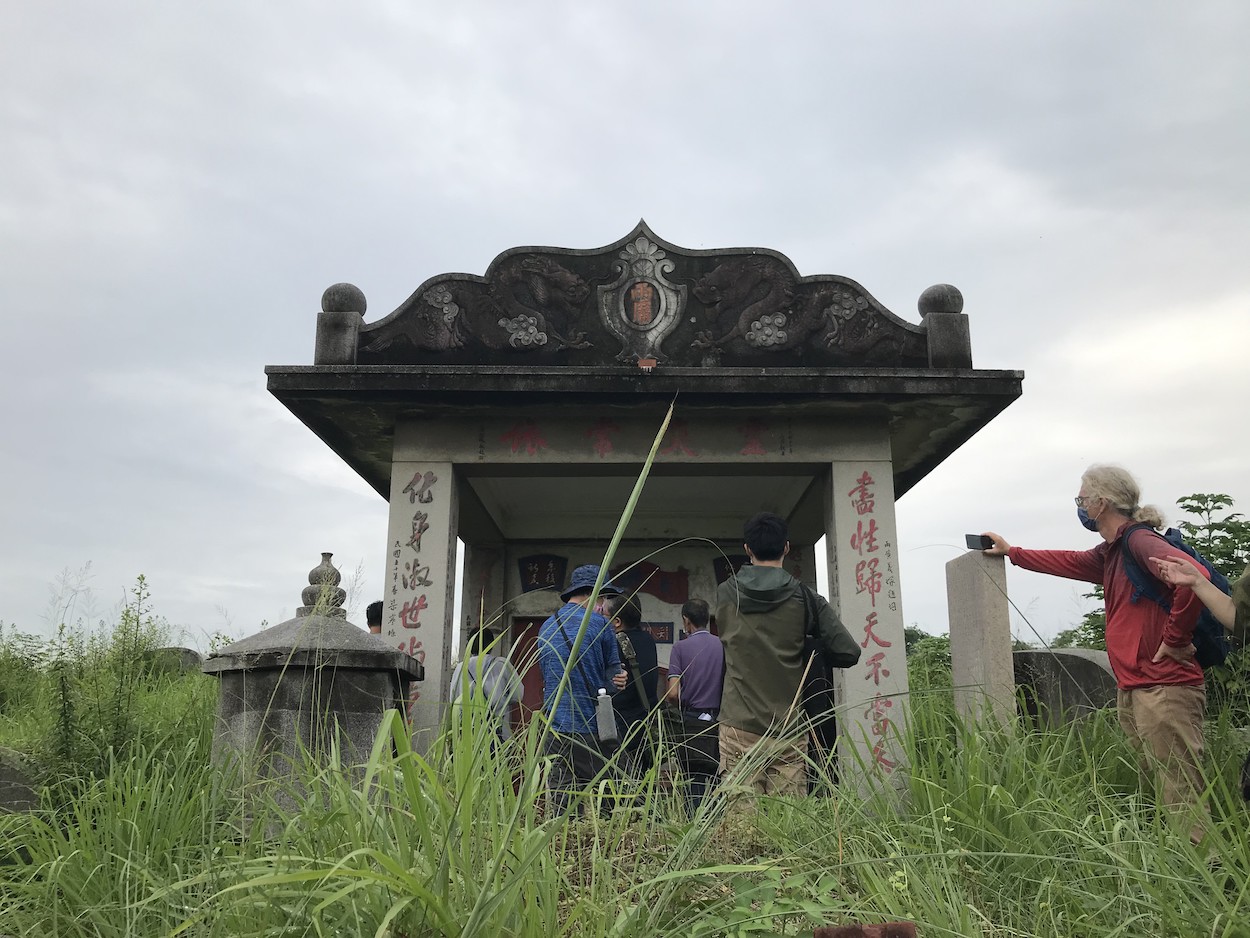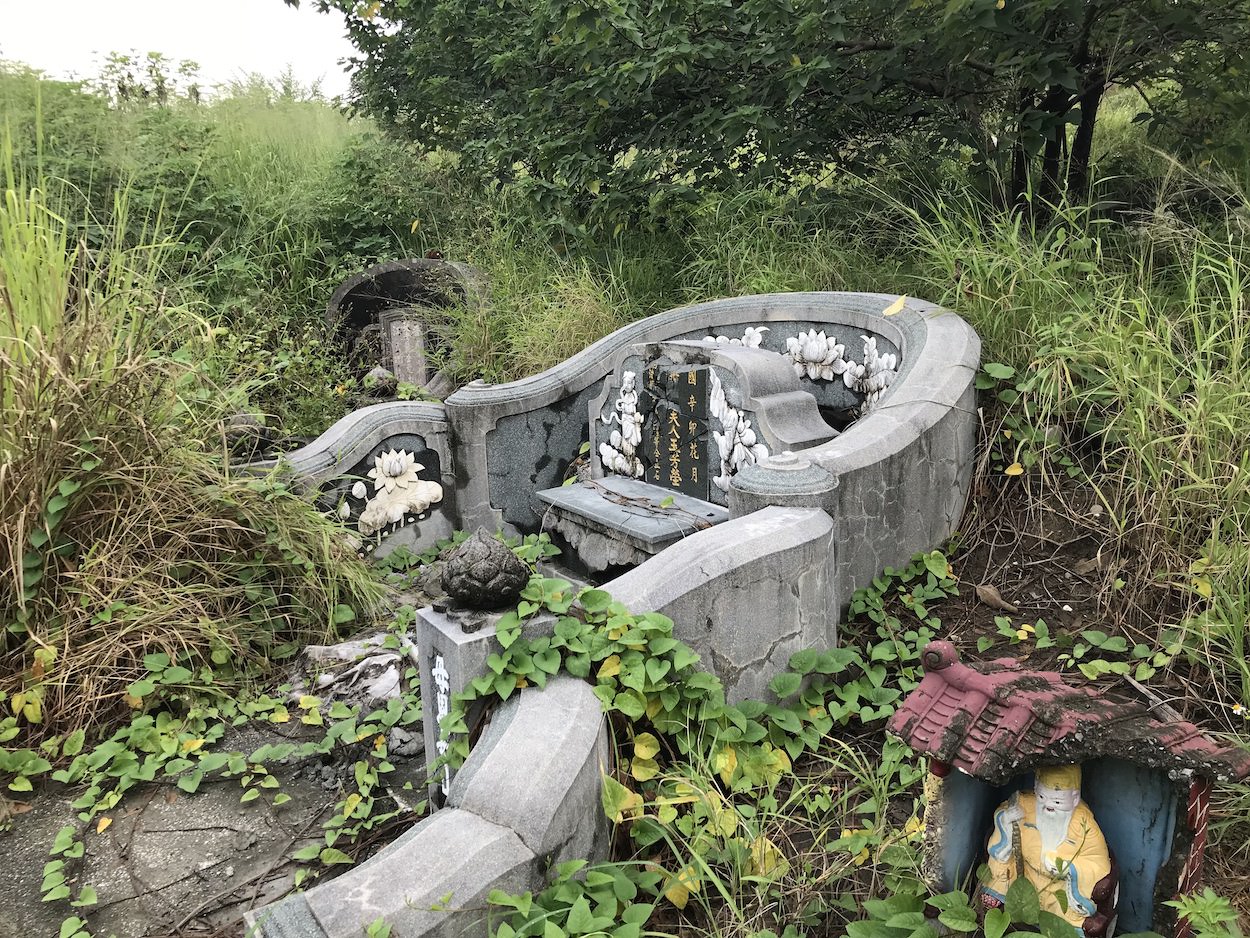by Brian Hioe
語言:
English
Photo Credit: Brian Hioe
SEVERAL DOZEN people gathered outside of a small temple at the Nanshan Public Cemetery in Tainan on the afternoon of October 15th. The event, which was a guided tour of the cemetery, was organized by a group of local residents and academics who have devoted themselves to calling for the cemetery’s preservation. Namely, the Tainan city government is planning on demolishing the cemetery for redevelopment, though technically the cemetery is undergoing an evaluation as to its cultural value.
Local resident Lin Shi-guang and others have called attention to the fact that the graveyard is the largest of its kind in Taiwan. The graveyard spans the entire history of Han settlement in Taiwan and includes within its premises the oldest known Han grave in Taiwan.

Photo credit: Brian Hioe
More than just graves, the tombs found in the cemetery prove an entry point into the vast tapestry of Taiwanese history. The different graves, for example, reflect different architectural styles. For example, it is easy to recognize graves from the Japanese colonial period due to their having vertical towers or having Japanese komainu present as an ornament.
Otherwise, one can tell a grave’s age from the inscription, even though sometimes the written year can be misleading—some graves go by the Republican calendar even retrospectively, back to years in which the Republican calendar was not in effect, as a signal of political views in death. Similarly, some graves from the Japanese colonial period leave out the Japanese reign year, also due to political leanings.
Some graves are those of paupers, such as those of KMT soldiers that came to Taiwan after the Chinese Civil War, and died unmarried, along with their peers. Still other graves are clearly those of the wealthy and powerful, including graves of prominent local families in Tainan, the first Taiwanese member of Academia Sinica after the institution relocated to Taiwan, or the first individuals to hold certain surnames in Taiwan.

Photo credit: Brian Hioe
Some graves themselves are of individuals wrapped up in history, such as of the only man able to win back land from the Japanese after Japanese colonization through a lawsuit. Another grave is of the Cheng (城) family, a surname that is held only by one family in Taiwan, with around 1,000 descendants. Although this family originally believed themselves to be from China, after failing to find family ancestors in China, they later discovered that they were actually of Japanese descent. Some graves reflect the twists and turns of Taiwanese history in their composition—because of the presence of a nearby airport that was attacked by the American air force during World War II, some graves have bullet holes from American planes.
Though to outsiders, graves may all look the same, they reveal much through the craftsmanship and materials with which they were made. Graves differ across Taiwan based on what material they are made of, depending on what materials were available and what they cost, while the artwork cut on graves varies based on the history of the person buried there and the values they wanted to signify in death. Some graves within the cemetery are of foreigners that died in Taiwan during pre-modern times.
Graves even have various ways of warding off thieves, including building a backup copy of a grave and burying it nearby, or carving the rock in such a way that it would shatter.

Photo credit: Brian Hioe
Not everything about the graveyard is known. There could be more graves buried underneath the current graves at the surface, for example. And a non-expert’s eye can be misleading. During the tour, Lin commented on news reports stating that Siraya and Dutch graves had been found in the graveyard that was quickly found to be false by experts.
Still, despite the wealth of stories that the cemetery has to offer—and could tell future generations—the Tainan city government has proven short-sighted in failing to realize how the cemetery is a cultural resource. It is more common for the city government’s construction workers to try and bury what they discover, to allow for future development.
Construction has been haphazard in the treatment of human remains, with Lin showing a tomb that had been broken open by construction workers before the cemetery researchers noticed and alerted the media. This left the bones within exposed to the elements, while still other bone fragments were thrown on the ground. Lin showed the group where human teeth had been discarded like refuse.

Tomb partially demolished by city government workers. Human teeth are strewn among the refuse. Photo credit: Brian Hioe
There may only be a brief window of opportunity to fight for the preservation of the Nanshan Cemetery, then. The Nanshan Cemetery is one of many graveyards in Taiwan slated for demolition, along with the historic Xindian Cemetery, as part of policies enacted by local governments to demolish graveyards with the view that they are an eyesore. Yet this is to bury Taiwan’s history in the process of digging it up.



